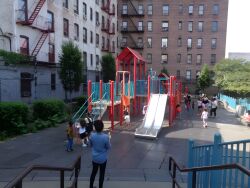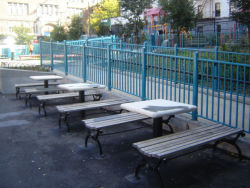Mabel Hampton Playground
Mabel Hampton Garden
What was here before?
This site was part of larger property owned by James Punnett (1819-1870), who rose from a cashier in 1846 to president of Bank of America by 1858. Five years earlier, he helped establish the New York Clearing House, which centralized settlements between banks.
By 1924, the formerly rural area had developed considerably, with an apartment building on this lot. In the intervening decades the building was demolished and turned into a Walton Avenue AB Playground, a play space and community garden owned by the Department of Housing Preservation and Development (HPD).
How did this site become a park?
NYC Parks acquired this property from HPD in 1997, after the agency reorganized and divested itself of its permanent park sites. The park was named Morris Garden after the adjacent Morris Avenue, which takes its name from the Morris family, 17th century Bronx landowners and subsequent generations of noted heirs.
Who is this park named for?
In 2021, as part of the second phase of NYC Parks’ initiative to expand the representation of African Americans honored in parks, this park was named for Mabel Hampton (1902-1989), prominent lesbian activist, performer, and philanthropist.
Hampton, born in 1902 in Winston-Salem, NC, was sent to live in New York City with family when she was seven after her mother and grandmother died. In less than a year, she ran away from her aunt and uncle’s apartment, and ended up in the care of a family in New Jersey.
Shortly after she arrived in the city when she was 17, Hampton was falsely accused of prostitution and imprisoned. After her release she moved to Coney Island where she sang and danced as part of an all-Black female ensemble before performing at the Garden of Eden and the Lafayette Theater during the Harlem Renaissance. Hampton spent much of her time in the company of famous queer Black women, like Ethel Waters and Gladys Bentley, and lived openly as a lesbian. Amid the Depression Hampton became a domestic worker where she worked for the family of Joan Nestle, who became a close friend and co-founder of the Lesbian Herstory Archives.
In 1932, Hampton met her lifelong partner Lillian Foster. They lived together at 639 East 169th Street in the Bronx since 1943. After their decades-long relationship, Foster died in 1978. Hampton found solace in her supportive community—marching in the first National March on Washington for Lesbian and Gay Rights, appearing in films Silent Pioneers and Before Stonewall, and cataloguing the stories of Black lesbians at the Lesbian Herstory Archives.
Hampton donated her collection of personal papers, memorabilia, and collection of lesbian pulp fiction novels to the Archives. In 1985, she was named the Grand Marshall of the New York City Pride Parade. Before she died in 1989, Hampton recorded several oral histories with Nestle, sharing an important look into the life of a Black lesbian in the early 20th century.
Check out your park's Vital Signs
Clean & Safe
Green & Resilient
Empowered & Engaged Users
Share your feedback or learn more about how this park is part of a
Vital Park System







